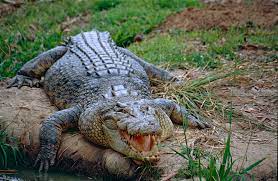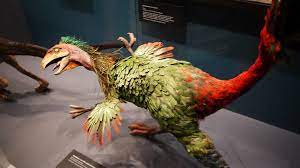In the early months of 1945, World War II was nearing its end. The Battle of Ramree Island in the larger Burma Campaign of the war would involve fierce fighting but it also reportedly involved animals like the deadly saltwater crocodile. Hundreds of Japanese soldiers fighting on Ramree Island are thought to have fallen prey to the huge reptiles, making the event the deadliest crocodile attack on humans in history.

The situation was the worst which could be imagined. One is a part of a military force that has been outflanked by the enemy on a tropical island. The force has to rendezvous with another group of soldiers on the other side of the island. However, the only way to do so is to travel through a thick swamp that is filled with deadly man-eating crocodiles. If the force didn’t attempt to cross the swamp, the enemy troops would close in on them while if it did attempt it, it would have to face the crocodiles. Would the force then risk the lives of the men in the swamp or take a chance with the enemy? This was the situation that had presented itself to Japanese troops who occupied the Ramree Island off the coast of Myanmar (formerly Burma) in the Bay of Bengal during World War II in the early months of 1945. Those who survived the battle against British and Allied troops didn’t fare well when they chose the doomed escape route across the crocodile-infested waters.
At the start of the battle for Ramree Island, the British forces needed an airbase on the island to launch more attacks against the Japanese on the mainland of Burma. But thousands of Japanese troops held the island at the time. This resulted in an exhausting battle that lasted for six weeks and resulted in a stalemate. Subsequently, the British Royal Marines along with the 36th Indian Infantry Brigade outflanked the Japanese positions and split the enemy group in two, and cornered around 1,000 Japanese troops.
The British then tried to negotiate a surrender with the smaller group of Japanese troops who had been surrounded. Though the unit was trapped and had no way to cross the British lines to reach the safety of the larger group of Japanese soldiers, they decided to break out of the British cordon and make their way to their larger group after crossing a mangrove swamp that was eight miles long.
It was at this point that things started going from bad to worse and the Ramree Island massacre began. The mangrove swamp was thick with mud and essentially a quagmire. The British troops monitored the situation from the edge of the swamp. They didn’t pursue the fleeing Japanese soldiers into the swamp as they knew that crocodiles awaited the Japanese inside the natural death trap that was the swamp.
Saltwater crocodiles are thought to be the largest reptiles in the world. Typical male saltwater crocodiles can reach 17 feet in length and 1,000 pounds in weight. The largest specimens are believed to have reached 23 feet and weighed 2,200 pounds. Swamps are the natural habitat of saltwater crocodiles and human beings cannot match their speed, size, agility, and raw strength.
The Japanese knew that saltwater crocodiles had a reputation for devouring human beings, but they still ventured into the mangrove swamp of Ramree Island. What followed was an incident similar to what had happened to the survivors of the sinking of the USS Indianapolis in the Pacific Ocean in July 1945, some months after the events on Ramree Island. During the sinking of the USS Indianapolis, the greatest recorded shark attack on humans occurred.
Soon after the Japanese soldiers entered the swamp, they began to die of diseases, dehydration, and starvation. Mosquitoes, spiders, venomous snakes, and scorpions hid in the dense forests of the swamp and attacked and killed some of the troops one after another.
Crocodiles appeared when the Japanese soldiers ventured deeper into the swamp. Another factor against the Japanese was that saltwater crocodiles were primarily nocturnal and excelled at hunting prey in the dark. Several British soldiers stated that the crocodiles had preyed on the Japanese troops in the swamp.
The most prominent account of what had happened was given by the naturalist Bruce Stanley Wright, who had participated in the battle for Ramree Island. According to Wright’s account the night of February 19, 1945, was the most dreadful that any member of the British motor launch crews experienced.
The crocodiles had been alerted by the sound of the fighting and the smell of blood. They had gathered among the mangroves and lay with their eyes above the water watching out for their next meal. When the tide ebbed, the crocodiles attacked the dead, wounded, and uninjured men who had gotten stuck in the mud of the swamp, according to Wright.
The night was filled with scattered rifle shots in the pitch-black swamp and the screams of wounded men who were crushed in the crocodiles’ jaws as well as the worrying sound made by the crocodiles doing their notorious ‘death roll’ on their prey. The combined effect of these sounds was as Wright called it, ‘a cacophony of hell’ which hadn’t been duplicated on earth. At dawn, the vultures came up to finish what the crocodiles had left.
Of the 1,000 Japanese troops who had entered the swamp on Ramree island, only 480 were reported to have survived. The Guinness Book of World Records listed the Ramree Island massacre as the largest crocodile attack on humans in history as per Wikipedia. But estimates of the death toll vary. The British captured 20 Japanese men who came out of the swamp alive. They told their captors about the crocodiles.
But exactly how many men died in the jaws of the huge reptiles is open for debate as no one knows for certain about how many troops died of disease, dehydration, or starvation as opposed to being killed by predators. But one thing is for certain. Whenever given the choice of surrender or taking chances in a crocodile-infested swamp, humans should choose surrender and not mess with mother nature.











